Picture this: a beautiful, plump, stately chicken that’s a hardy egg layer and an excellent meat bird.
Wouldn’t you love to add such a chicken breed to your backyard? If yes, you will be interested in learning more about the Orpington chicken breed.
These striking chickens originate from Orpington, Kent in southeast England.
Orpingtons became popular as soon as they were created and have been a favorite among chicken farmers ever since.
In this article, we will examine the features of this majestic chicken breed to help you decide whether it would be a worthy addition to your backyard flock.
Let’s get started.
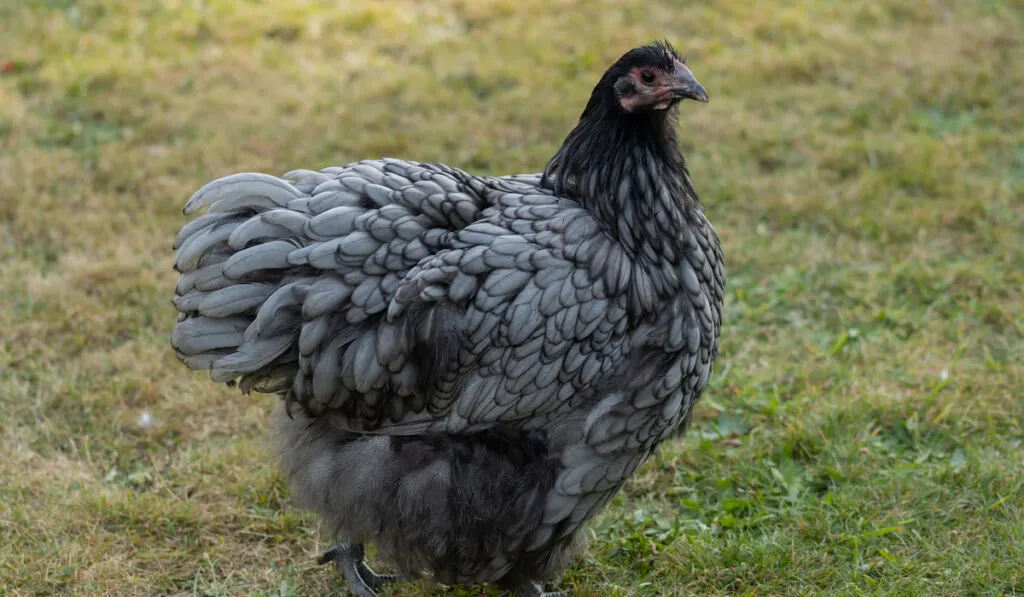
Table of Contents
History
William Cook, one of the greatest breeders of all time, created the beautiful Orpington chicken in 1886.
He intended to create a beautiful, easy-to-breed, dual-purpose hen that would be a hardy layer and a great table bird.
He also wanted to produce a black bird that would hide the dirt and soot from London factories, but other colors would also emerge.
To create the breed, William first crossed Black Plymouth Rocks and Minorcas. He then bred the female progeny from this crossing with Croad Langshan cocks.
The result was a shiny, green-black fowl with soft contours and plenty of body.
William took his newly-created chicken breed to the London Dairy Show in 1886, where he wanted to prove to everyone that the Orpington could replace any other chicken breed out there.
He advertised the birds as hardy winter layers that were great table birds and beautiful enough to win poultry shows while being easy to breed.
This was much to ask from a new chicken breed, but the Orpington did not disappoint and became a massive hit.
William selected the breed’s predecessors carefully to ensure the Orpington had all the qualities he desired in a chicken.
The Minorca breed gave the Orpington its excellent egg-laying capacity.
The Black Plymouth Rock gave it the large, meaty carcass, while the Croad Langshan chicken breed is responsible for the Orpingtons’ large dark eggs.
The breed’s popularity grew, eventually reaching the U.S. in 1895 when William Cook exhibited it at Madison Square Garden.
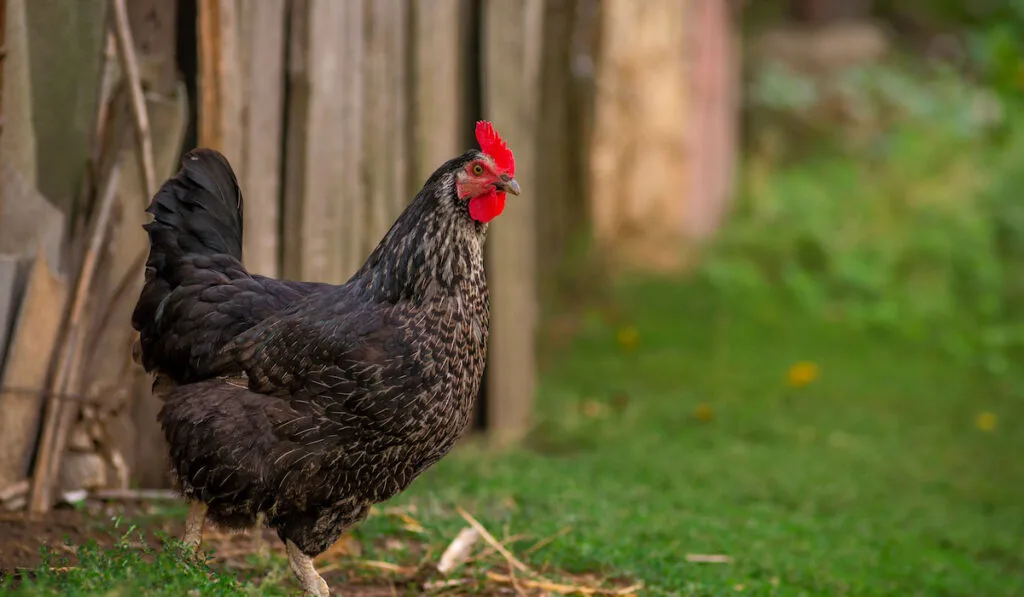
Breed Standard and Varieties
Orpington chickens are available in different color varieties. However, only four of these varieties are recognized by the American Poultry Association:
- Buff Orpington — added to the APA registry in 1902
- Black Orpington — added to the APA registry by 1905
- White Orpington — added to the APA registry by 1905
- Blue Orpington — added to the APA registry by 1923
Out of these, the Buff Orpington is by far the most popular color variety with backyard poultry enthusiasts. The soft golden pigmentation on its fluffy feathers provides an aesthetic value that captivates most people.
The stunning beauty of the Buff Orpington has seen it win many awards in poultry shows over the years.
Here are several color varieties popular with poultry farmers but not yet added to the APA registry:
- Lavender Orpington
- Red Orpington
- Cuckoo Orpington
- Spangled Orpington
- Chocolate Orpington
- Golden-Laced Orpington
- Silver-Laced Orpington
Following the success of the Orpington chicken breed, a German by the name Herman Kuhn set out to develop its bantam variety.
Luckily, he was successful in this task. He created a bantam variety with the exact appearance of the full-size fowl.
And just like the large fowl, the bantam variety comes in a variety of colors. However, only four color varieties are recognized by the American Poultry Association:
- Black Bantam Orpington
- Blue Bantam Orpington
- Buff Bantam Orpington
- White Bantam Orpington
Appearance
The Orpington chicken is a large fowl with a broad body. The birds have soft, fluffy feathers that make them appear massive.
The mass of feathers provides insulation against cold temperatures, thus helping the bird endure cold winters.
Moreover, the birds have deep breasts and slightly curved short backs. Additionally, the birds have a U-shaped underline and clean, short legs.
They also carry themselves low because of their weight.
Orpingtons also have small heads with single medium-sized combs. The combs have five points, although some birds have rose combs with no spikes.
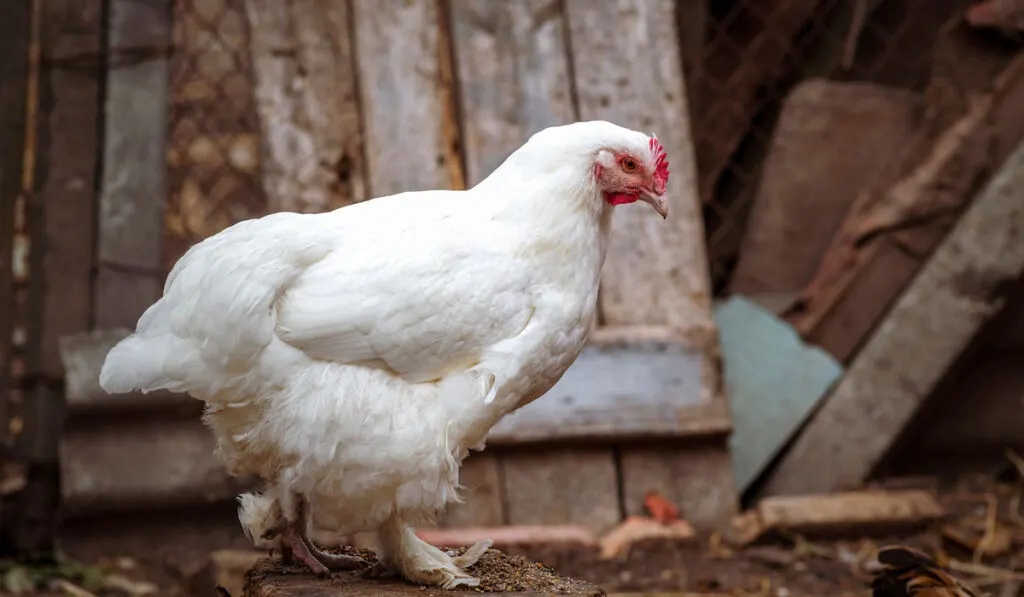
Compared to other chickens, Orpingtons are neat birds. They hide dirt and soot properly just as William Cook had intended.
Their shanks and feet are always clean and maintain their pinkish-white color throughout the year.
Regardless of their color variety, Orpingtons have red ear lobes, wattles, and combs with short pinkish-white beaks.
Lastly, the eyes of these beautiful birds are reddish-bay in color.
Size
Although Orpington birds look huge, their appearance is greatly exaggerated by their feathers.
That said, here are the standard weights of the Orpington chicken breed and bantam variety.
| Chicken | Weight (lbs.) |
| Rooster | 8 to 10 |
| Hen | 6 to 8 |
| Bantam Rooster | 3 to 4 |
| Bantam Hen | 2 to 4 |
Uses
The Orpington chicken breed is an excellent utility breed that can be kept for both meat and eggs.
This all-purpose breed is also bred for poultry shows, with its striking features stealing the hearts of many at poultry exhibitions.
Egg Production
Present-day Orpingtons have an average egg-laying capacity. The hens lay 3 to 4 eggs per week, translating to approximately 175 to 200 eggs per year.
However, it’s believed that Orpington hens had a higher egg-laying capacity, producing as many as 340 eggs in a year.
Orpington egg production declined over the years as breeders prioritized looks over production.
The hens mature early and lay large, light-brown eggs throughout the seasons.
Meat Production
Orpingtons are good sources of meat due to their large size. They produce a large chunk of meat, making them a great choice for small farmers who want to raise chickens for meat.
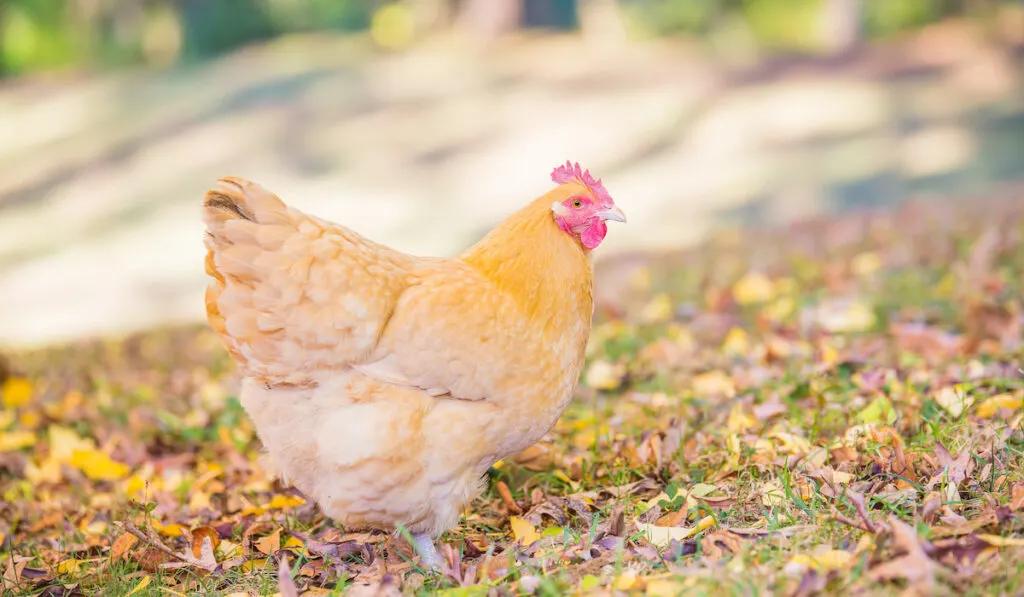
Backyard Behavior
Orpingtons are docile and friendly birds that are great to have around, especially the Buff variety. These chickens are stately and calmly move around the barnyard without haste, unless going for treats.
Orpington chickens are also easy to handle, hence making great pets. When they need human attention, they are not afraid to let you know that they want to be cuddled.
This makes the Orpington a great choice for families who want to keep chickens as pets.
The Buff Orpington is particularly superb with kids and can tolerate the things that children do.
However, you should be careful when cuddling these birds since they have a powerful beak that delivers painful pecks.
While their calm demeanor makes them good lap buddies, it could prove problematic inside the coop, as it makes the birds an easy target for more assertive breeds.
Rarely will you find an Orpington throwing a hissy fit unless you’re trying to take eggs from a broody hen.
Orpingtons like to forage for bugs and other tasty treats. However, they also take confinement very well and would gladly eat from the feeder provided in the coop.
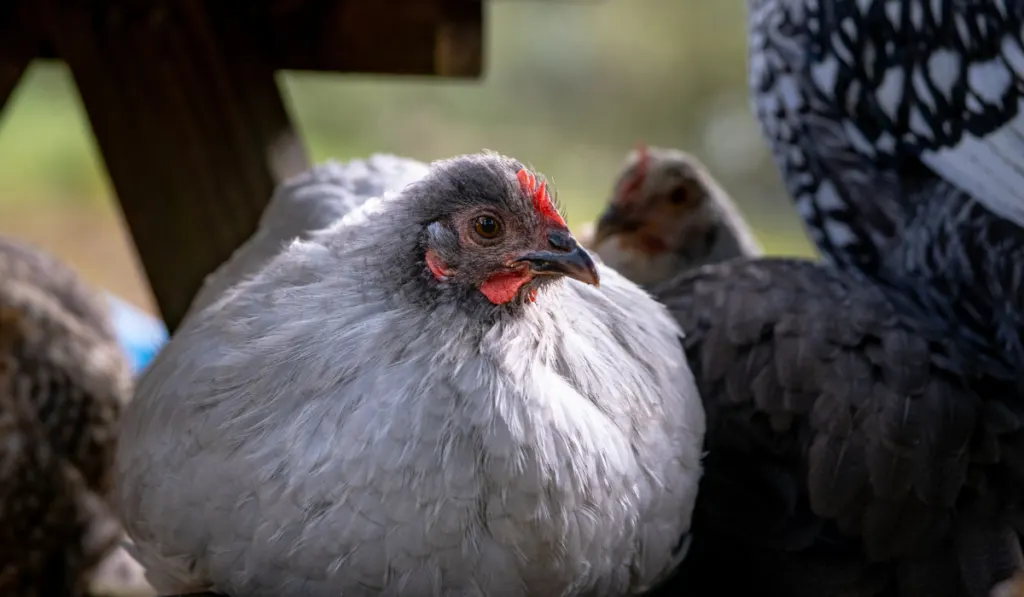
Broodiness
Orpingtons are great, broody chickens and easily accept eggs to be placed under them. They also make good mothers and watch over their chicks keenly.
Orpington roosters are unusually gentle and may even sit on the eggs to give the mother hen a break.
Hardiness
The Orpington is a cold-hardy breed that continues laying eggs through cold winters with dark, short days.
They have better feathering than many other chicken breeds, which keeps them warm throughout the cold winter months.
However, their heat tolerance is low, and they need plenty of shade to get through a hot day.
Housing
Orpingtons are large birds and need a lot of space to be comfortable. Ideally, you should give each bird at least 4 sq. ft. of coop space.
If you’re keeping different fowl in your coop, provide at least 6 sq. ft. of space to each bird to make it easy for your Orpingtons to escape unwanted attention.
Orpingtons also love to spread their wings, so allocate a perching space of approximately 8 to 10 inches.
A standard nesting box measuring 12 x 12 inches is sufficient for your hens.
And if you’re going to keep the birds confined, each bird will need a run space of about 8 to 10 square feet to freely roam about.
You don’t have to worry about building a large fence since Orpingtons are not flighty birds.
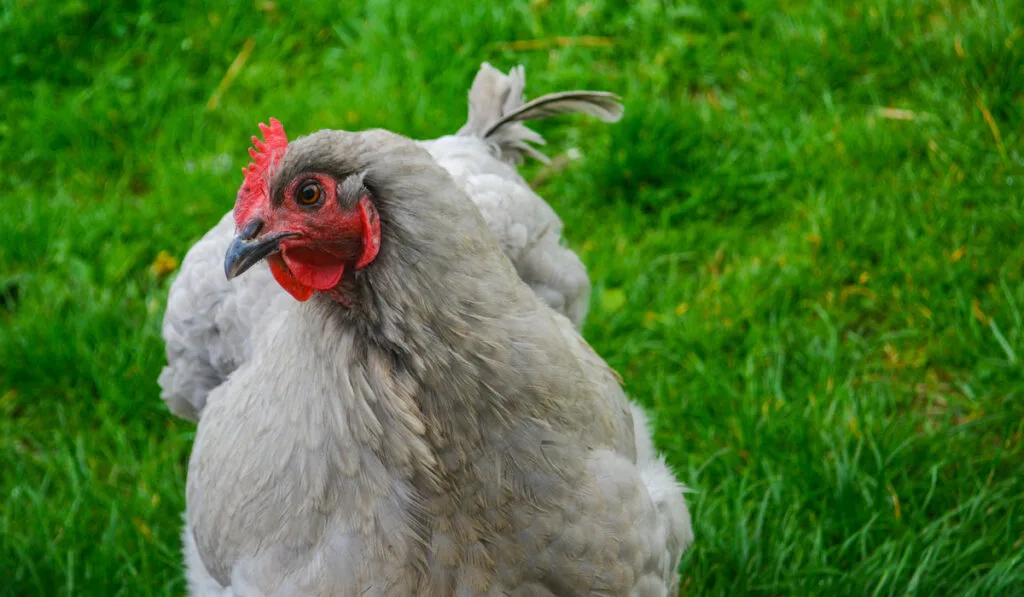
Health Issues
Orpingtons are robust chickens that do well in cold temperatures. However, their heat tolerance is low, and they can die if they don’t get enough ventilation and shade on extremely hot days.
In addition, their thick feathers can pick up mites and lice, so make sure to apply poultry dust regularly as directed by your vet to keep these lousy pests at bay.
Their biggest problem, however, tends to be their weight. As large birds, Orpington chickens can become obese unless they get enough exercise, hence the need to free-range them.
Final Thoughts
With all its impressive features, the Orpington stands out as one of the best options for chicken farmers and poultry enthusiasts.
This all-purpose breed has everything you’d want in a chicken. It is beautiful with plenty of body and a decent egg-laying capability.
It is also friendly and loves to be cuddled, making it a great pet for your children.
Keep your Orpingtons away from other aggressive fowl that can attack and injure them.
Resources
- https://breeds.okstate.edu/poultry/chickens/orpington-chickens.html
- https://www.backyardchickencoops.com.au/blogs/learning-centre/breed-profile-orpington
- https://www.thespruce.com/chicken-breeds-orpington-or-buff-orpington-3016551
- https://www.roysfarm.com/orpington-chicken/
- https://en.wikipedia.org/wiki/Orpington_chicken
- https://agro4africa.com/orpington-chicken/
- https://www.agrifarming.in/orpington-chicken-facts-profile-characteristics
- https://www.chickensandmore.com/orpington-chicken/
- https://poultrykeeper.com/chicken-breeds/orpington-chickens/
- https://agronomag.com/orpington-chickens/
- https://cluckin.net/the-orpington-chicken.html#mcetoc_1fd7qamet2o
- https://farmhouseguide.com/orpington-chicken-breed-profile/
